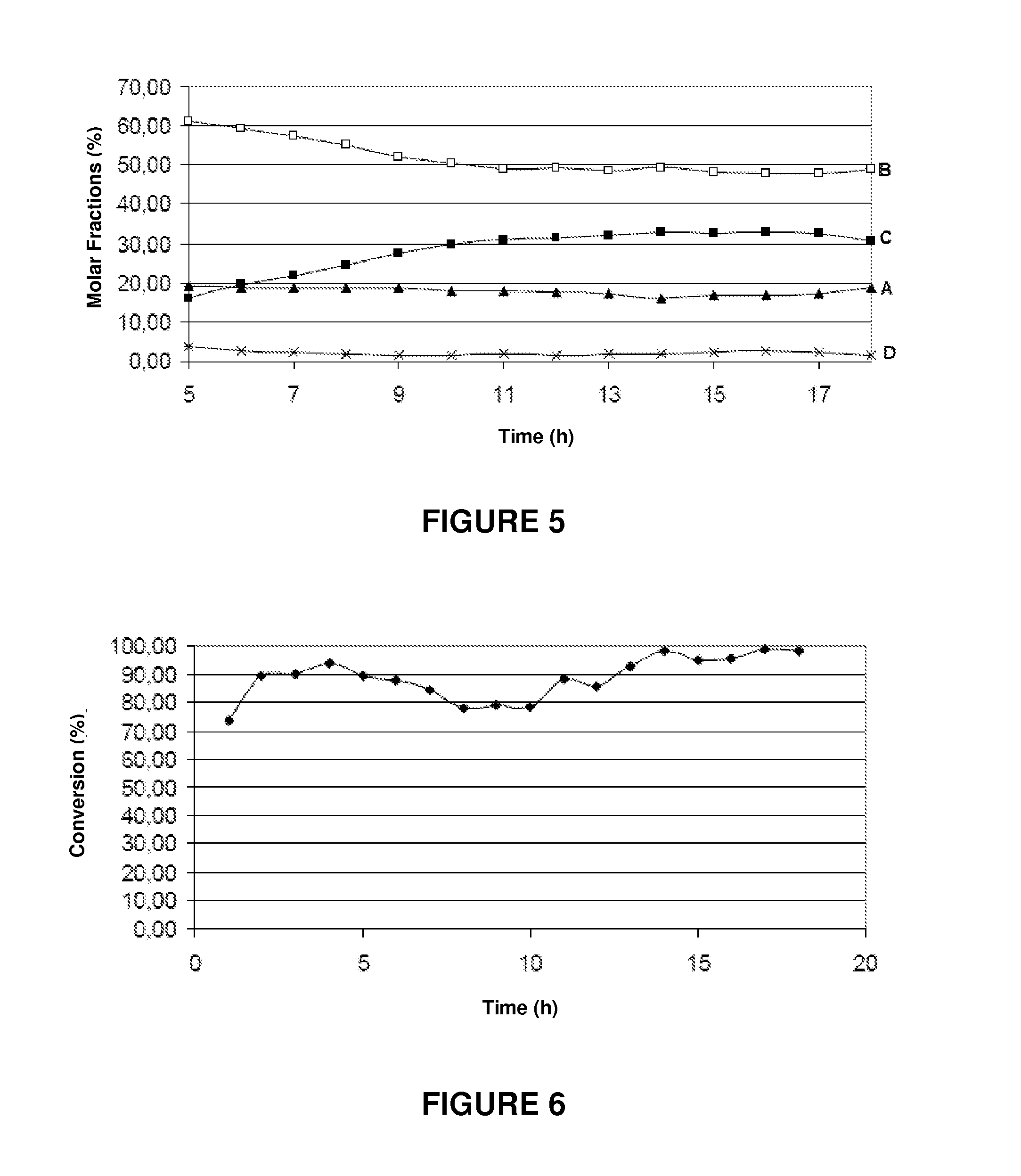Steam reforming process for reducing the tar content of synthesis gas streams
a technology of synthesis gas and steam reforming, which is applied in the direction of combustible gas purification/modification, physical/chemical process catalysts, bulk chemical production, etc., can solve the problems of low removal efficiency, tar as a contaminant, deposits and obstructions of equipment used, etc., to increase the useful life, prevent deactivation, and high activity and stability
- Summary
- Abstract
- Description
- Claims
- Application Information
AI Technical Summary
Benefits of technology
Problems solved by technology
Method used
Image
Examples
example 1
Barium and Calcium Titanate Based Catalysts
[0058]The barium titanate based catalyst exhibited a minimum purity of 99.1% and contained maximum alumina contents of 0.20%, SiO2 2 of 0.15%, Fe2O3 of 0.05 and Na2O of 0.10.
[0059]The calcium titanate based catalyst had a minimum purity of 99.1% and contained maximum alumina contents of 0.20%, SiO2 2 of 0.20%, Fe2O3 of 0.05 and Na2O of 0.10.
[0060]Its surface areas are respectively, 0.90 m2 / g and 13.6 m2 / g, as determined by the nitrogen absorption technique.
[0061]X-ray diffraction analysis confirmed that the main crystalline phase of the catalysts was barium titanate and calcium titanate, and X-ray fluorescence analysis showed that they contained minor impurities, as may be observed in Table 1 below.
TABLE 1Characterization by X-ray diffraction and X-ray fluorescenceMain crystalline phasesidentifiedFRX (% m / m)BaTiO3Ba = 53Ti = 23Na = 0.9Sr = 0.7Zr, S, Ca, P, Si CaTiO3Ti = 36Ca = 27Zr = 0.8Si = 0.2Sr = 0.1Ba = 0.1Mg, Fe, P, Al, Cl, S
example 2
Iron Titanate (Ilmenite) Based Catalysts
[0062]The iron titanate based catalyst exhibits a surface area of 5.4 m2 / g as determined by the nitrogen adsorption technique.
[0063]X-ray diffraction analysis confirmed that the main crystalline phase of the catalysts exhibited FeTiO3 and Fe2TiO3, and X-ray fluorescence analysis showed the presence of minor components, such as Mn, Si, Mg and Zr, as may be observed in Table 2 below.
TABLE 2Characterization by X-ray diffraction and X-ray fluorescenceMain crystalline phasesidentifiedFRX (% m / m)FeTiO3 and Fe2TiO3Fe = 29Ti = 31Al = 1.2Mn = 1.0Si = 0.8Mg = 0.2Zr = 0.1S, Ca, P, Pb, As, Nb
example 3
Activity of the Catalysts Using a Single Bed
[0064]In the experiments conducted for measuring the catalytic removal activity of the tar, the tar was simulated using toluene, to facilitate analysis of the reaction products.
[0065]Toluene and water were separately fed to the unit, vaporized and mixed with nitrogen, used as carrier gas and fed at a flow rate of 10 ml / min.
[0066]The reaction products were analyzed on-line by chromatography using a gas chromatograph with two thermal conductivity detectors and a flame ionization detector
[0067]The reaction pressure was kept constant at 4 atm and the steam / carbon ratio was 1.5 mol / mol, with the temperature being varied during the experiments between 500° C. and 700° C.
[0068]The results of the catalytic removal of tar in the presence of water vapor (measured by the toluene conversion) are shown in Table 3 below.
TABLE 3Tar Removal Activity(temperature equal to 650° C. and atmospheric pressure)Type of catalystX %Barium titanate30Iron titanate44Ca...
PUM
| Property | Measurement | Unit |
|---|---|---|
| Temperature | aaaaa | aaaaa |
| Temperature | aaaaa | aaaaa |
| Pressure | aaaaa | aaaaa |
Abstract
Description
Claims
Application Information
 Login to View More
Login to View More - R&D
- Intellectual Property
- Life Sciences
- Materials
- Tech Scout
- Unparalleled Data Quality
- Higher Quality Content
- 60% Fewer Hallucinations
Browse by: Latest US Patents, China's latest patents, Technical Efficacy Thesaurus, Application Domain, Technology Topic, Popular Technical Reports.
© 2025 PatSnap. All rights reserved.Legal|Privacy policy|Modern Slavery Act Transparency Statement|Sitemap|About US| Contact US: help@patsnap.com



